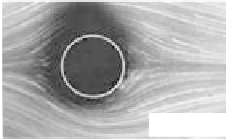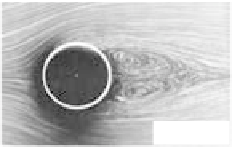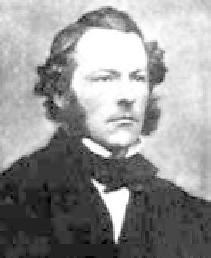Geoscience Reference
In-Depth Information
10
3
Stokes law
V
p
=
0.22(
)
gr
2
/
s
−
r
h
10
2
Re
g
= 26
experiment
10
1
Re
g
= 13.1
10
0
10
-1
silt
sand
gravel
10
-2
10
-1
10
0
10
1
Re
g
= 1.5
Sphere diameter, mm
Fig. 4.31
Experimental determination of fall velocity for silica spheres in water at STP.
The mass term per unit volume is expressed as the effective
density, (
), of the solid. Note that the sign of the
overall density term defines whether ascent or descent will
take place. The only appropriate viscosity term is that of
the ambient fluid molecular viscosity,
F
weight
=
F
viscous
F
weight
=
mg
= 1.33
pr
3
(
s
−
r
)
g
.
F
viscous
= 6
phrV
p
1.33
pr
3
(
s
−
r
)
g =
6
phrV
p
4.7.2
Stokes law
)
gr
2
/
V
p
=
0.22(
s
−
r
h
Spheres introduced singly into a static liquid initially accel-
erate, the acceleration decreasing until a steady velocity,
known as the
terminal
, or
fall velocity
is reached.
Experimental data for smooth quartz spheres in water
(Fig. 4.31), shows clearly that the fall velocity increases
with increasing grain diameter but that the rate of increase
gets less. Accurate prediction of the rate of fall is only pos-
sible for one highly specialized case; that of the steady
descent of single, smooth, insoluble spheres through a still
Newtonian fluid in infinitely wide and deep containers
when the grain Reynolds number is low (
Stokes
Fig. 4.32
Stokes approach.
Box 4.1
For multiple particles, the Richardson-Zaki expression rules.
c
)
n
V
mp
V
p
(1
where
c
is the volume concentration of particles,
n
varies between
2.32
(Re
p
500) and 4.65 (
Re
p
0.2).
1.5) so there is
no viscous flow separation (Fig. 4.31).
Concerning the general problem of predicting the rate
of fall (Figs 4.30 and 4.32), we might surmise that the ter-
minal velocity varies directly with density contrast,
(
considered viscous fluid resistance forces only and arrived
at a theoretical relation that expressed fall velocity as a
function of particle and fluid properties (Fig. 4.32).
During steady fall, all acceleration terms in the equations
of motion vanish, leaving a balance between the solid par-
ticle's immersed weight force and the viscous drag force
acting over the solid particle surface. Stokes' law very
accurately predicts the fall velocity of spherical particles
whose particle Reynolds number is
), size,
d
, and gravity,
g
, while varying inversely with
fluid viscosity,
. We then write a functional relationship
(see appendix) of general form
V
p
. This
leaves the determination of proportionality constant(s) to
experimentation. Another solution is the approach of the
mathematical physicist (Stokes), to solve the problem by
recourse to the fundamental equations of flow. Stokes
f
(
)
dg
/
0.5. As viscous
and then turbulent separation occurs around particles






























Search WWH ::

Custom Search